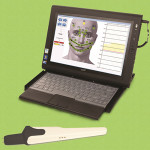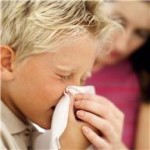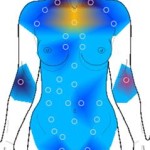Medical Science Revolutionized – Using Thermography to Detect Illnesses
 Apparently efficiency works by using various techniques in order to root out the problem; for example farmers would use fertilizers and pesticides on top of their crop-cultivating methods to bring out the best harvest each year. The same is true when it comes to medical science and what could not be determined or identified through standard means; often a radical method is intuitively conceived and developed to not only locate but pinpoint the source of the condition. Doctors then will know the best way to deal with the condition and cure it. Thermography is one such efficient method of discovering medical conditions that X-ray and other medical evaluation means could not accomplish on their own.
Apparently efficiency works by using various techniques in order to root out the problem; for example farmers would use fertilizers and pesticides on top of their crop-cultivating methods to bring out the best harvest each year. The same is true when it comes to medical science and what could not be determined or identified through standard means; often a radical method is intuitively conceived and developed to not only locate but pinpoint the source of the condition. Doctors then will know the best way to deal with the condition and cure it. Thermography is one such efficient method of discovering medical conditions that X-ray and other medical evaluation means could not accomplish on their own.
What is Thermography?
Thermography is a method employing the use of thermal scanning to view things in the infrared spectrum. It was originally developed for military applications which enables military personnel seek out targets in areas considered as “zero visibility.” Thermography highlights the heat signatures of objects and especially biological life forms, because most creatures are naturally warm blooded just like humans are. Doctors thought that Thermography might be useful in diagnosing diseases that under normal medical standards would be almost impossible to trace, despite the fact that the patient experiences genuine symptoms of the disease. Indeed Thermography proved itself to be a very useful technology in the advancement of medical science and its non-invasive properties make it a very popular alternative to x-ray and MRI. It’s also cheaper to opt for this type of detection and the procedure itself is fairly quick as well.
under normal medical standards would be almost impossible to trace, despite the fact that the patient experiences genuine symptoms of the disease. Indeed Thermography proved itself to be a very useful technology in the advancement of medical science and its non-invasive properties make it a very popular alternative to x-ray and MRI. It’s also cheaper to opt for this type of detection and the procedure itself is fairly quick as well.
How does it help in Detecting Illnesses?
 It was equally fascinating and surprising when doctors first used Thermography to detect arthritis, neck and back pain, dental issues, headaches and sinus issues, immune dysfunction, fibromyalgia and chronic fatigue, carpal tunnel syndrome, digestive disorders, pain related to varicose veins and even breast cancer! It’s amazing how through the use of thermal imaging you can actually see temperature changes on parts of the human body where there is pain; The heat pattern indicate various types of illnesses and pain, thus helping doctors pinpoint accurately the pain center as well as the type of disease that the patient is suffering from.
It was equally fascinating and surprising when doctors first used Thermography to detect arthritis, neck and back pain, dental issues, headaches and sinus issues, immune dysfunction, fibromyalgia and chronic fatigue, carpal tunnel syndrome, digestive disorders, pain related to varicose veins and even breast cancer! It’s amazing how through the use of thermal imaging you can actually see temperature changes on parts of the human body where there is pain; The heat pattern indicate various types of illnesses and pain, thus helping doctors pinpoint accurately the pain center as well as the type of disease that the patient is suffering from.
Thermography Procedure
If you’ll undergo a thermal scan or Thermography you will be surprised at how fast the procedure is being done, because the scan will last to no more than 10 minutes each time. The process starts with you being asked to step into a temperature-controlled room, the room’s temperature is set to 70°Fahrenheit – this is important because it encourages your organs to react to the cold except where there are some issues. Your body will be scanned in 120 points ranging from your head all the way down to your pelvic area. After a cooling period the scan will de done a second time. Once the procedure is done the thermograph specialist will review the results of the thermal scans and will write a report about it based on his expert interpretation and will submit it to the doctor. The doctor will then conclude whether or not you are suffering from any illnesses or pains.
Thermography may be the best Medical Evaluation tool for Detecting Breast Cancer?
Having non-invasive and non-radioactive properties, Thermography could be the best detecting procedure in  detecting breast cancer. According to the American Cancer Society (ACS) there are approximately 232,340 new cases of invasive breast cancer in women in the United States alone as of 2013. In the early stages of breast cancer about 64,640 women in America are in carcinoma in situ (CIS) and roughly 39,620 women have died due to not being able to survive against this disease. Even if you think you don’t have breast cancer it would be prudent to undergo Thermography regularly just to make sure, it just might save your life as you will be able to deal with breast cancer early on and have the doctors cure it rather than being sorry later on. It is good to note that there are also 2.9 million breast cancer survivors in the U.S. and most of those who have had the cancer removed while it was still in its early stages underwent Thermography. Technology, if used for good, will not only help improve our lifestyle but save lives as well.
detecting breast cancer. According to the American Cancer Society (ACS) there are approximately 232,340 new cases of invasive breast cancer in women in the United States alone as of 2013. In the early stages of breast cancer about 64,640 women in America are in carcinoma in situ (CIS) and roughly 39,620 women have died due to not being able to survive against this disease. Even if you think you don’t have breast cancer it would be prudent to undergo Thermography regularly just to make sure, it just might save your life as you will be able to deal with breast cancer early on and have the doctors cure it rather than being sorry later on. It is good to note that there are also 2.9 million breast cancer survivors in the U.S. and most of those who have had the cancer removed while it was still in its early stages underwent Thermography. Technology, if used for good, will not only help improve our lifestyle but save lives as well.
Advantages of Thermography
The best advantage that Thermography has is that it is non-invasive when used as an  evaluating tool for various medical conditions. But there are also other advantages that Thermography has especially in medical science and among them include early stage disease detection, pain detection, breast imaging for cancer detection, detects vein, muscular and tendon injuries as well as detecting malignant cysts. Kinesiotherapy (physical therapy) also uses thermograph to determine the progress of muscle development in paraplegic and hemiplegic patients, which is common to stroke patients. Thermography doesn’t use harmful alpha or beta rays which are typical in x-ray machines and mammograms and is therefore very safe to use in diagnosing patients.
evaluating tool for various medical conditions. But there are also other advantages that Thermography has especially in medical science and among them include early stage disease detection, pain detection, breast imaging for cancer detection, detects vein, muscular and tendon injuries as well as detecting malignant cysts. Kinesiotherapy (physical therapy) also uses thermograph to determine the progress of muscle development in paraplegic and hemiplegic patients, which is common to stroke patients. Thermography doesn’t use harmful alpha or beta rays which are typical in x-ray machines and mammograms and is therefore very safe to use in diagnosing patients.
Conclusion
The biggest impact that Thermography has brought to society is that it could now be used to detect possible breast cancer in women earlier and will therefore reduce the fatalities of cancer patients. This is very significant as the number of breast cancer patients (especially women) have increased 2-4 times in the last 2 decades. We may not totally eradicate breast cancer in the world, but we sure can help a lot of women cure theirs before it develops into something worse by detecting it early. Thermography will be one of the methods in medical science that will pave the way in detecting, alleviating and curing diseases.
Johanna Oosterwijk N.D.
